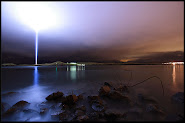*****************************************
As Europe mourns in Verdun today for those lost in "The War to End All Wars", World War I, we could look to another moment in European history to shed light on the most aggressively silenced story of the Bush administration.
In late 2000 and January 2001, reports were exploding across Europe about the rise in cancer amongst NATO soldiers who had served in the "peacekeeping missions" in Bosnia and Kosovo. The effects of the depleted uranium in the U.S. and U.K. weapons could not be ignored.
But history shows that the United Nations and the World Health Organization could be intimidated. The report from the WHO – that detailed how the DU vaporized upon impact into tiny particles that were breathed in, or consumed through the mouth or entered through open wounds, where the irradiating bits attacked cells all the way through the body, causing mutations along the way – was shelved under pressure from the U.S.
Even now, the major U.S. news organizations do not touch the subject, though the international press cannot ignore it. Even last month, a Middle Eastern Reuters reporter discussed the health damages because of the contaminated environment with Iraqi Environment Minister Nermeen Othman,
"When we talk about it, people may think we are overreacting. But in fact the environmental catastrophe that we inherited in Iraq is even worse than it sounds."
And The Tehran Times further endangers their country by continuing to report on the problem, calling it a war crime.
And across the internet, retired Air Force Lt. Col. Roger Helbig seeks to intimidate anyone who dares to bring up the subject.
But we evolve, and the United Nations First Committee has overwhelmingly passed a resolution , on October 31st, calling for "relevant UN agencies, in this case the International Atomic Energy Association (IAEA), World Health Organisation (WHO) and United Nations Environment Programme (UNEP) to update and complete their research into the possible health and environmental impact of the use of uranium weapons by 2010." The only countries that voted against it were the United States, the United Kingdom, Israel and France.
Meanwhile, to help the reader get to the point, I've put together the following. Although the facts, for the most part, do not contain links, there is a list of the references at the end.
Ten Essential Facts:
1. Depleted uranium, the nuclear waste of uranium enrichment, is not actually "depleted" of radiation; 99.3% of it is Uranium238, which still emits radioactive alpha particles at the rate 12,400/second, with an estimated half life of 4.5 billion years.
2. Depleted uranium is plentiful - there are 7 pounds remaining for every pound of enriched uranium - and requires expensive and often politically-contentious hazardous waste storage.
3. Depleted uranium is less of a problem for the nuclear industry when it is cheaply passed on to U.S. weapons manufacturers for warheads, penetrators, bunker-busters, missiles, armor and other ammunition used by the U.S. military in the Middle East and elsewhere, and sold to other countries and political factions.
4. Depleted uranium is "pyrophoric", which makes it uniquely effective at piercing hard targets, because upon impact, it immediately burns, vaporizing the majority of its bulk and leaving a hard, thin, sharpened tip - and large amounts of radioactive particles suspended in the atmosphere.
5. Depleted uranium weaponry was first used in the U.S. bombing of Iraq in 1991, under President George H. W. Bush and Defense Secretary Dick Cheney.
6. Depleted uranium weaponry was later used by President Bill Clinton in the NATO "peace-keeping" bombing missions in Bosnia, Kosovo and Serbia. By January 2001, as the 2nd President Bush and Dick Cheney were moving in to the White House, there was a furor in Europe over the news of an alarming increase in leukemia and other cancers amongst the NATO troops who'd served in the Balkans.
7. The World Health Organization suppressed a November 2001 report on the health hazards of depleted uranium by Dr. Keith Baverstock, Head of the WHO's Radiation Protection Division and his team, commissioned by the United Nations. Baverstock's report, "Radiological Toxicity of Depleted Uranium", detailed the significant danger of airborne vaporized depleted uranium particles, already considerably more prevalent in Iraq than the Balkans due to the difference in military tactics, because they are taken into the body by inhaling and ingesting, and then their size and solubility determines how quickly they move through the respiratory, circulatory and gastrointestinal systems, attacking and poisoning from within as they travel, and where the damages occur. In addition, the report warns that the particles tend to settle in the soft tissue of the testes, and may cause mutations in sperm. In 2004 Dr. Baverstock, no longer at the WHO, released the report through Rob Edwards at Scotland's Sunday Herald.
8. The George W. Bush/Dick Cheney administration twisted the meaning of the failure of the World Health Organization to produce evidence of depleted uranium's health hazards, turning it into evidence that there was no link between exposure to depleted uranium and the increases in cancer in Europe and Iraq; instead, as presented in the January 20, 2003 report by the new Office of Global Communications, ironically titled Apparatus of Lies: Saddam's Disinformation and Propaganda 1990 - 2003, the depleted uranium uproar was only an exploitation of fear and suffering. Two months later, Bush-Cheney-Rumsfeld-Wolfowitz-Rice began to "Shock and Awe" Baghdad by again dropping tons of depleted uranium bombs on densely populated areas.
9. On March 27, 2003, significant increases in depleted uranium particles in the atmosphere were detected by the air sampler filter systems of the Atomic Weapons Establishment at 8 different sites near Aldermaston Berkshire, Great Britain, and continued at 4-5 times the previous norm until the end of April 2003, after the Coalition forces declared the war over. This information only came to light in a report on January 6, 2006 by Dr. Chris Busby, due to his diligent fight for access to the data through Britain's Freedom of Information law.
10. We have a new, intelligent President, who is willing to listen. It is up to us to bring this to his attention. THIS IS HOW WE CAN HONOR VETERANS.
***************************************

VALUABLE REFERENCES:
Campaign Against Depleted Uranium. http://www.cadu.org.uk/ Founded by one of the great long-time scientist/activists, Dr. Rosalie Bertell.
International Coalition to Ban Uranium Weapons (ICBUW) is probably the best of the best all-in-one place http://www.bandepleteduranium.org/.
Department of Defense description of self-sharpening depleted uranium: click here
Dr. Keith Baverstock's November 2001 report, suppressed by the World Health Organization:http://www.mindfully.org/Nucs/DU-Radiological-Toxicity-WHO5nov01.htm
Rob Edwards article on Baverstock: http://www.robedwards.com/2004/02/who_suppressed_.html
Karen Parker, a Human Rights and Humanitarian Law Lawyer: http://www.webcom.com/hrin/parker.html Scroll down on the page and you'll find her documents on DU.
January 2003 White House Report - Apparatus of Lies: http://www.whitehouse.gov/ogc/apparatus/suffering.html
January 2006 Chris Busby report: click here
***********************************************
COMMENTS FROM THE OPEDNEWS POST
From "editnetwork":
"Traces of uranium" found at bombed Syrian plant
My first thought at seeing that headline was: "depleted uranium."
It's truly a crime that our outgoing administration somehow is escaping all accountability as it waltzes out the door. They are getting away with this horror of irradiating a population in Iraq that posed no threat to us and had been systematically weakened by ten years of sanctions, supposedly directed against their leaders. Now the displaced truly have no home to which to return, no water to safely drink, etc., because of lingering radiation. (Of course our civilian contractors supply safe water, etc., to the occupying "warfighters.")
All this lasting destruction thanks to us. Some legacy. I have no reason to doubt that the arms we give or "sell" to Israel are just as "advanced" and were used against the Syrian installation they destroyed and probably stand ready for use anywhere else in the region they decide to strike. Hence the "traces of uranium" which scientists will no doubt find a way to construe as evidence that the Syrian plant was bent on nefarious (nuclear) ends.
I may be proud to live in a free country, but I am not repeat not proud of the mark the U.S. is making on this planet and the ruin we are wreaking in the lives of countless humans and uncounted ecosystems.
***
From "editnetwork":
Note to Barbara -- requesting clarification
In your first listed point of information:
'Depleted uranium, the nuclear waste of uranium enrichment, is not actually "depleted" of radiation; 99.3% of it is Uranium238, which still emits radioactive alpha particles at the rate 12,400/second, with an estimated half life of 4.5 billion years.'
For "12,400/second" to be meaningful, it should be per given unit of mass (weight): for example, alpha particles 12,400/second/kg or whatever. I am unable to find the factor and hope your research will turn it up.
In fact, that "per weight" factor will turn out to be rather high, because with such a long half-life the radiation is fairly low-level. This in NO way diminishes the hazard of exposure to this material or the criminality of its continued use in weapons, whether against civilian or military populations.
Thank you -- the editor person
***
From Me (BBT):Dr. Rosalie Bertell
Here is the article full of excellent information by Dr. Rosalie Bertell written for the May 1999 Hague Peace Conference, entitled "Gulf War Veterans and Depleted Uranium" from which I got those specific statistics: http://www.ccnr.org/du_hague.html.
The point is that the public is fooled by the term "depleted", which generally means "empty", which seems to indicate that it is harmless.
Similarly, the term "low-level radiation" results in another misconception. I am not a scientist, but I do understand that 12,400 emissions per second indicates a great deal of blasting. It turns out that the term "low-level" refers to the size of the distance the emission travels, not the power of the blast.
While I may be able to stand a few feet away from a chunk of depleted uranium and not be affected by it, because the emissions don't reach me, if instead there is a particle of it in my body, the cells that are next to that particle that is working its way through the gastrointestinal or respiratory system, for example, are being constantly bombarded, and change as a result.
For the universe of my body, there is nothing low-level about the experience.
Thank you for asking for more clarification. I hope this helps.
***
From "editnetwork":
Thank you for clarifying
The article for which you posted a link helped enormously, and I hope everyone reads it.
The portion that clarified the statistic for me is this paragraph:
"Natural uranium in soil is about 1 to 3 parts per million, whereas in uranium ore it is about 1,000 times more concentrated, reaching about 0.05 to 0.2 percent of the total weight. Depleted uranium concentrate is almost 100 percent uranium. More than 99 percent of both natural and depleted uranium consists of the isotope U-238. One gram of pure U-238 has a specific activity of 12.4 kBq, which means there are 12,400 atomic transformations every second, each of which releases an energetic alpha particle. Uranium 238 has a half life of 4.51 E+9 (or 4.51 times 10 to the 9th power, equivalent to 4,510,000,000 years)."
So the emission rate is 12,400 per second per gram of U-238, much more than I realized. And even though they are low-energy (velocity) alpha particles (helium nuclei, two protons with two neutrons), they are massive and do considerable subatomic damage when they do strike -- as do ingested particles of this material, no matter how small.
Especially enlightening was the section a bit later in the article was the treatment of decay products, one kind after another decaying into further radioactive isotopes. The final resting stage of this process is atoms of lead, which noboty wants in their system.
Thanks again for raising this terribly important issue.
***
From Me (BBT):My Thanks for Your Follow Through
It is that concern to really know what's being said, so you, too, can consider its meaning and what you can do about it, that encourages me.
More important, it creates the public dialogue which is so profoundly called for, so we can put an end to the use of depleted uranium in weaponry.
Thank you.
***
From Me (BBT):
Writing about DU
I should mention that I first learned about depleted uranium on Memorial Day 2005. It took me more than a year and a half to dare to post anything anywhere about it, but during that time I gathered a ton of articles and reports, so when I did finally say something, I could back it up.
Some people who write about Depleted Uranium are so frustrated (understandably) that they let their need to be heard outshine the facts, and those who want this embarrassing and potentially expensive liability silenced are ready and willing to jump on that weakness.
I've been pleased that my presentation of the essentials has been reviewed and confirmed by two of the top experts in the field. Phew.
It is a sad tale, but it must be faced.
***
From Me (BBT):
P.S.
I noticed that this article has been picked up and posted on a blog.
When I visited the blog, there he was, that retired Lt. Col. Roger Helbig I mentioned in the article, to criticize the blogger for posting "lies about depleted uranium", saying that no one ever reads the referenced reports.
So, I wonder, did Helbig actually read the article? Does he actually criticize an article that points out that he may show up to criticize it?


















No comments:
Post a Comment